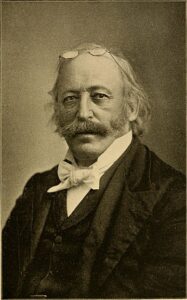
Isaac Mayer Wise (March 29, 1819 – March 26, 1900) was born in Steingrub, (now Lomnička, modern day Czech Republic) to schoolteacher Leo Weis and his wife Regina. His father and grandfather provided his early religious education, which he built upon in Prague. In 1843, he was appointed as a rabbi in Radneitz (today Radnice), remaining there for two years before immigrating to the United States in 1846. He changed his surname to Wise.
In 1846, he was appointed rabbi of Congregation Beth-El in Albany, spending eight years there. His congregation was one of the earliest to count women in the minyan; allow men and women to sit together in family pews; eliminate the bar mitzvah ceremony and replace it with a confirmation ceremony, which was also available to girls; and have a mixed-gender choir.
On Rosh Hashanah in 1850, defenders and detractors of Rabbi Wise physically fought over his having been quoted as saying he didn’t believe in the coming of the Messiah nor in the resurrection of the dead. Sheriff’s officers had to clear the synagogue and Wise was dismissed as Beth El’s rabbi. This caused a schism, with Wise and his supporters forming a new congregation, Anshe Emeth. In 1852, Wise supplemented his Ansche Emeth salary with a second salary as chaplain of the New York State Legislature. That was arranged by U.S. Sen. William Seward, who later would become U.S. Secretary of State and architect of the purchase of Alaska.
In 1854, Wise relocated to Cincinnati, Ohio, where he secured a lifetime appointment as rabbi of Beth K.K. B’nai Jeshurun congregation, also known as the Lodge Street Synagogue, and established his own newspaper, The Israelite. In 1855, his prayer book, Minhag America, was adopted for use in many congregations across the country. In 1866, an architecturally grand Plum Street Temple was built, which since 1931 has been known as the Isaac M. Wise Temple.
As for the great moral issue of the day – slavery – Wise defended the biblical version of the practice, while criticizing some aspects of the chattel slavery practiced in America.
In 1875, his dream of opening Hebrew Union College to train rabbis was realized, with Wise serving as its president. In 1883, non-kosher food was served to the first graduating class at what became known derisively as the “Trefa Banquet,” which Wise declined to condemn. This incident led to the formation of the Conservative movement, which positioned itself as more liberal than Orthodox Judaism, but conserving many traditions.
Wise pushed for creation of an organization that would unify all Reform rabbis under a single umbrella organization, which was realized in 1889 with the creation of the Central Conference of American Rabbis.
Wise’s first wife, Therese Bloch, and he had 10 children, eight of whom survived him: Emily, Leo, Julius, Ida, Isidor, Helen, Iphigene (who married newspaper publisher Adolph Ochs), and Harry. Therese died in 1874. Two years later, he married Selma Bondi, with whom he had four children: Elsie, Rabbi Jonah Bondi Wise, Regina, and Isaac.
Tomorrow, March 30: Alex Bregman
*
SDJW condensation of a Wikipedia article supplemented by the Jewish Virtual Library.
One little correction:
Among Cincinnati Jews, The Plum Street Temple is still called The Plum Street Temple. The Isaac Wise Temple is a different congregation in a completely different part of town, Amberly Village, just south of the Mayerson JCC.